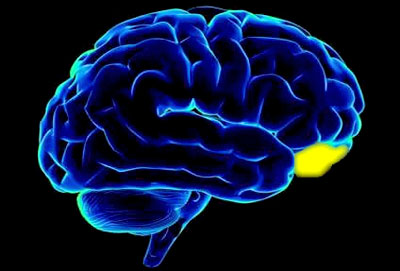|

by Marco Torres
February 22, 2012
from
PreventDisease Website
Spanish version
|
Marco Torres is a
research specialist, writer and consumer advocate for
healthy lifestyles. He holds degrees in Public Health
and Environmental Science and is a professional speaker
on topics such as disease prevention, environmental
toxins and health policy. |
Our tendencies to react and adapt to the standards placed on us by
society are changing and at a physical level we are finding out why.
For the first time, scientists are
seeing consistent changes in the amount of grey matter in one
specific brain region responsible for conforming to social
pressures.

Individuals are presented with many
choices in life, from political alignments to choosing which
sandwich to eat for lunch.
People are realizing that the right of
choice is a universal right, not a privilege. Their eventual
decisions can be influenced by the options chosen by those around
them. Although differences in individuals’ tendencies to conform to
social pressures are commonly observed, no anatomical measure has
previously been linked to the likelihood of someone conforming under
the influence of their peers.
Many have addressed the
changing tone in our society.
People are fed up with what is happening
around them. They are tired of the corruption, greed, control and
manipulation of national and international governments at all
levels. The breaking point in human beings may have arrived and the
evidence is in the brain.
Research funded by the Danish National Research Foundation and the
Wellcome Trust, scientists at New York University, Aarhus University
and the Wellcome Trust Centre for Neuroimaging at UCL (University
College London) have identified the specific brain structures that
are now predicting how and why society is reacting to social
pressures.
Their approach involved a technique known as
voxel-based morphometry
allowing researchers to measure the volume of grey matter (the nerve
cells where the processing takes place) from three-dimensional
images of the brain provided by magnetic resonance imaging (MRI)
scans.
Strikingly, only grey matter volume in one precise brain region -
the lateral
orbitofrontal cortex - was associated with this measure
of social influence.
The linear relationship between grey
matter volume and the tendency of individuals to conform was
observed in this particular region in both hemispheres of the brain.
"The most impressive correlation we
are seeing in brain scans throughout the world is that this grey
matter volume is increasing in people of all ages," said
neuroscientist Agata Petrova.
"This suggests that a greater
percentage of populations may reject common social influences,"
she added.
There has been many studies on how
meditation is facilitating structural changes which are found in
areas of the brain that are important for sensory, cognitive and
emotional processing.
"What is most fascinating to me is
the suggestion that meditation practice can change anyone's grey
matter," said Jeremy Gray, an assistant professor of psychology
at Yale.
Since more people are meditating to
reach spiritual destinations, their brains are evolving with their
intentions.
In a previous study, the UCL researchers had looked at the level of
activity in the participants’ brains when faced with disagreement
with the experts. This activity predicted how much influence the
experts would have. By comparing the measures in this new study with
the previous findings, they were able to show that grey matter
volume in the lateral orbitofrontal cortex also predicted how
individuals responded when the critics disagreed with their
opinions.
These findings suggest that the brain region is particularly tuned
to recognizing cues of social conflict, such as when someone
disapproves of a choice, which may prompt the subject to update
their opinions accordingly.
Study leader Professor Chris Frith says:
“The ability to adapt to others and
align ourselves with them is an important social skill. However,
at what level is this skill implemented in the brain? At a
software (information processing) or hardware (structural)
level? Our results show that social conformation is, at least in
part, hard-wired in the structure of the brain.”
Dr Daniel Campbell-Meiklejohn,
first author of the study, explains the implications of their
findings:
“This finding suggests that perhaps
we should look at how these individuals learn what is important
from the expressed preferences of others.”
Hacking grey matter has also been an
accomplished by those with musical training.
In
a 2003 Journal of Neuroscience paper
Gaser and Schlaug reported that professional musicians had increased
gray matter volume in motor, auditory and visual-spatial brain
regions compared to amateur musicians and non-musicians.
"We are beginning to see an
evolution of the human brain that has never been studied or
historically reported anywhere," said Psychology professor Altan
Korkmaz.
"This may potentially have very
exciting and profound implications in the areas of human
behavior in the future."
Korkmaz says that increasing grey
matter and neuronal, neurofibral and dentrite activity in the
cerebral cortex is not difficult for those wishing to accelerate the
process.
"Neurogenesis in the brain can be
significantly increased by exercise. This greatly increases the
brain-derived neurotrophic factor (BDNF), a key component in
brain growth."
According to Korkmaz, exercise can
stimulate and double BDNF peaking about 90 minutes to 2 hours after
vigorous exercise.
What are we to expect from these revelations? It is often said that
a group of people can never change at once, only one at a time.
However, it seems that there is now conclusive evidence that human
brains are changing everywhere and almost simultaneously.
The cause may be attributable to either,
-
changing thought patterns
-
releasing outdated societal values
-
embracing the versatility of the human dynamic,
...or all of the above.
Whatever it is, it will likely change
the world.
|

